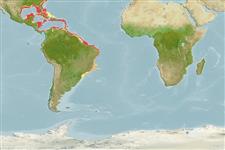Environment: milieu / climate zone / depth range / distribution range
Écologie
marin récifal; profondeur 10 - 210 m (Ref. 27283). Subtropical; 35°N - 33°S, 98°W - 33°W
Western Atlantic: Bermuda, Florida (USA), western Bahamas, and Gulf of Mexico to Brazil. Also Caribbean, including Antilles (Ref. 26938).
Taille / Poids / Âge
Maturity: Lm ? range ? - ? cm
Max length : 28.0 cm TL mâle / non sexé; (Ref. 7251); common length : 17.0 cm TL mâle / non sexé; (Ref. 3798)
Épines dorsales (Total) : 13; Rayons mous dorsaux (Total) : 13 - 14; Épines anales: 3; Rayons mous anaux: 8. Scale rows below lateral line oblique; head entirely scaled except for front of snout near upper lip and front of chin; snout very short; the maxilla not reaching a vertical through center of eye; silvery gray with five dusky yellow stripes, the two lowermost the broadest (Ref. 13442).
Occurs along exposed outer or deeper reefs. Found on semi-hard substrates (Ref. 5217). Maximum depth down to 210 m was recorded from individuals observed by submersibles (Ref. 27283). Feeds mainly on plankton (Ref. 5217); small crustaceans (Ref. 26938).
Life cycle and mating behavior
Maturité | Reproduction | Frai | Œufs | Fécondité | Larves
Oviparous, distinct pairing during breeding (Ref. 205).
Robins, C.R. and G.C. Ray, 1986. A field guide to Atlantic coast fishes of North America. Houghton Mifflin Company, Boston, U.S.A. 354 p. (Ref. 7251)
Statut dans la liste rouge de l'IUCN (Ref. 130435: Version 2024-2)
Menace pour l'homme
Harmless
Utilisations par l'homme
Pêcheries: intérêt commercial mineur; Aquarium: Aquariums publics
Outils
Articles particuliers
Télécharger en XML
Sources Internet
Estimates based on models
Preferred temperature (Ref.
123201): 21.4 - 27.8, mean 25.5 °C (based on 392 cells).
Phylogenetic diversity index (Ref.
82804): PD
50 = 0.5000 [Uniqueness, from 0.5 = low to 2.0 = high].
Bayesian length-weight: a=0.00389 (0.00180 - 0.00842), b=3.12 (2.94 - 3.30), in cm total length, based on all LWR estimates for this body shape (Ref.
93245).
Niveau trophique (Ref.
69278): 3.4 ±0.45 se; based on food items.
Résilience (Ref.
120179): Milieu, temps minimum de doublement de population : 1,4 à 4,4 années (Preliminary K or Fecundity.).
Fishing Vulnerability (Ref.
59153): Low vulnerability (18 of 100).
Nutrients (Ref.
124155): Calcium = 34.2 [13.8, 82.1] mg/100g; Iron = 0.663 [0.314, 1.363] mg/100g; Protein = 19.2 [17.2, 21.1] %; Omega3 = 0.141 [0.067, 0.284] g/100g; Selenium = 17.4 [7.6, 38.1] μg/100g; VitaminA = 82.8 [27.5, 263.2] μg/100g; Zinc = 0.829 [0.501, 1.409] mg/100g (wet weight);
